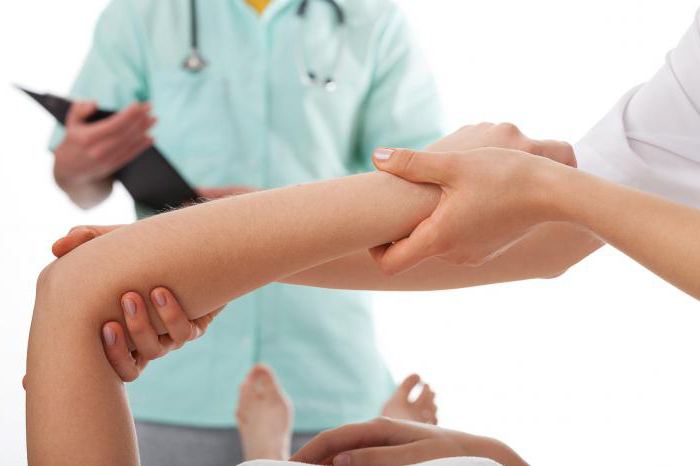No one is safe from injuries (bruises, dislocations and fractures). They happen as a result of severe overloads, falls, bumps. Today we will consider in detail the types and signs of ulnar fractures . Immediately make a reservation that such an injury does not occur too often. But a fracture of the ulna requires special attention, since it can impair the mobility of the arm.
What is a fracture?
A fracture is a violation of the integrity of the bone tissue of the skeleton as a result of mechanical stress, when the load on the bone exceeds its strength. It can be full or partial, with displacement of bone processes and without it. Sometimes they say that there is no fracture, just a crack. But this is a mistake! A crack is an incomplete fracture of a bone, because its integrity is still broken.
Fractures are traumatic or pathological in nature. Traumatic injuries occur as a result of external exposure, and pathological ones as a result of the influence of painful deviations, for example, as a result of tuberculosis or a tumor.
The structure of the ulna
The ulnar and radial bones are joined together and form the forearm. The bones are parallel. The body of the ulna is slightly longer. In addition, it has two ends with protruding processes: the ulnar and coronal (top) and awl-shaped (bottom). The processes are separated by a block-shaped notch, to which a block of the bone of the shoulder adjoins. The ulnar process of the ulna is a prominent place for attaching the triceps and ulnar muscles. The coronoid process provides articulation of the ulna and radius. The styloid protrudes at the bottom of the bone and is easily palpated above the wrist. These tubular bones are located between two joints:
- from above - ulnar;
- below - wrist.
The ulna and radius are articulated in such a way that they provide pronation and supination of the forearm. Pronation is the ability to turn the forearm inward, with the palm of the hand looking down. Supination - rotation outward when the palm is turned up.
The structure of the ulna is very complex. Injury (fracture) can occur in any part.
Types of fractures of the ulna
The ulna is most often damaged in athletes, children and the elderly. The reasons are commonplace. Athletes overload bones, children are excessively mobile, and their bones are not fully formed. Well, old people are weakening due to age characteristics. Their bones are more sensitive to calcium deficiency and become more fragile. Although with a lack of calcium, the risk of injury increases in all categories of people.
In medicine, several types of fracture of the ulnar bones are distinguished:
- Damage to the ulnar process. Usually the cause of such a fracture is trauma. This is a drop on the elbow or a direct blow. Fracture can be oblique or transverse. Depending on the state of the muscles, various degrees of appendix displacement can be observed.
- Fracture of Malgenya. With such an injury, a fracture of the appendix and dislocation of the bones of the forearm occurs. The hand takes a half-bent position, the palm is turned forward. The joint is enlarged and deformed. In addition to a traumatologist, a neurosurgeon or pediatric neuropathologist (in case a child is injured) should be invited.
- Injury in which a dislocation of the head of the beam occurs. Another name is the Montagei fracture. May be open or closed. Joint mobility is greatly limited. The forearm appears to be shortened on the injured side. In difficult cases, surgery is needed. The Montegi fracture of the ulna can be damaged in two types - flexor or extensor. The type of fixation depends on the type of damage.
- Fracture of the elbow. One of the most common injuries. Movement in the joint is very limited. The pain extends to the shoulder and forearm. A swelling is observed, a bruising forms.
- Fracture of the diaphysis. The diaphysis is the central part of the tubular bones. Debris offsets are rare. An intact radial bone prevents this. Deformation of the arm is observed.

Common symptoms
The ulna in case of damage (fracture) looks somewhat deformed. The soft tissues around the swollen, movements are difficult and are accompanied by pain. Symptoms of a fracture may vary, they depend on the type of injury.
Fracture diagnosis
If you fall, hit, or jerk, causing severe pain, it is necessary to quickly appear to a traumatologist. A fracture of the ulna can have serious consequences. To avoid this, it is important to get timely help.
The traumatologist conducts a visual examination of the damaged limb and appoints an x-ray. Using an X-ray, the doctor determines the type of fracture. In addition, he may consider whether the ulna is displaced at the site of injury. The fracture treatment option depends on this. In difficult cases, the victim will need surgery.
Treatment
Diagnosis by a traumatologist reveals the complexity of the problem. If a fracture of the ulna or elbow bone is not complicated by displacement, then a plaster cast is applied to the patient and a support bandage is recommended. A week after the cast is applied, a control x-ray is prescribed to ensure that no bias has occurred. The plaster cast is removed no earlier than 3 weeks later.
In case of displacement of bone fragments, the patient undergoes surgery. This can be a resection of the proximal fragment or the installation of a plate with screws to fix injured bones. After the operation, a plaster cast is used to immobilize the limb.
To restore mobility after a fracture, massages, physiotherapy and special exercises are prescribed.